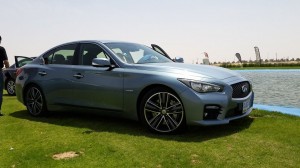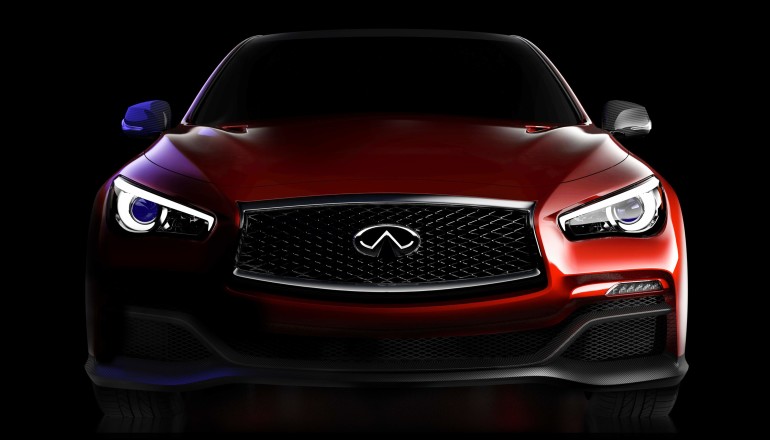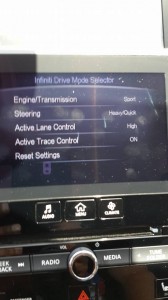In those days of my motorcycle diaries, I was mostly riding pillion to a brother whose name if it weren’t to be Alex, famously coming to mean ‘instinctive driving’ among friends and family, would certainly have been Harley! Once as I wavered a little before a parked bus, not knowing what lay ahead on those single carriage ways where the left lane is nothing but an overtaking lane for oncoming traffic till approximately six inches from your fender, the Zen whispered to me, “Bro, now you are ready for the advanced lessons in riding. Tell me, how will you discover what lies ahead?” I looked back at him through my helmet, without blinking. “Just tilt your bike and take a quick, deep look under the bus to see if there is a vehicle ahead!”
Brilliant! Ingenious! Big bro saved his nose and I kept my humor sense, but right now, as I drive the Infiniti Q50, I have wiped my smirk as the truth settles in: that is exactly what Infiniti has done in the new Q50. It detects the action of the car that is beyond the one ahead of us using sensors fitted low enough to take a peek through the underside of the car in front and prepare us for eventualities we can’t possibly see! That’s how different the thinking behind the Q50 is, demonstrated for you.
The natural and the hybrid
In the Infiniti Q50, the engines have been retained with the naturally aspirated 3.7 L V6 being what most buyers this side of the world would go for. Infiniti’s first hybrid power train mates the 3.5-litre V6 petrol engine with Infiniti’s Direct Response Hybrid System delivering net 350 horsepower and 536Nm of combined torque with Intelligent Dual Clutch Control, making it capable of reaching 100km/h from a standing start in 5.1 seconds. The 50 kW electric motor is rated at 67 horsepower and 270 Nm of torque which is why the Hybrid is much more torque-inducing. The sportily agile 3.7-litre V6 engine from the earlier G37 generates 326-horsepower and 361 Nm of torque. All models are linked to a 7-speed automatic transmission with available solid magnesium paddle shifters.
The hybrid is torquier thanks to the electric motor boost that works on the 3.5L engine. It’s almost impossible to drive the car on electricity alone even though Nick from Infiniti said it does work till almost 60 kmph provided you get there on feather feet. Anyway, that doesn’t matter much to anyone other than trivia buffs because you might never, ever stay on electrical mode alone. In our Autodrome drive, the mode did not last longer than the few seconds needed to demonstrate its graphic representation before the screen intimated the V6 activation. Anyway, once the battery is drained around 30% the recuperation keeps happening. The Ecomode sticks a spanner between the floor and the accelerator making a vain and tedious exercise out of acceleration per se. Opening up the throttle was much like a long distance call to Alaska during snowfall.
Despite all this hullaballoo about future technology and eco-friendly hybrids, the fuel efficiency hasn’t changed much and hovers around 7 km per L, on a mix of track and pure highway. It beats me how the Nissan Altima with the same 3.5L engine as the Hybrid delivered 8.6 km/L on my test drive.

The four-wheel arrangement of the braking force hold out on a straight line but you need to crash in hard to get the braking distance to the claimed 114 feet.
Design and Cabin
The legacy of the G sedan isn’t easily forgotten and along the gleaming new sheet metal and under it as well, the car doesn’t hide its origins, though the mesh grille gives the new car a more aggressive look and uncanny similarities with the Lexus ISF. The Q50 looks quite impressive and nicely sculpted into a balanced size and shape, which bears a glint of luxury just as it stays loyal to its sporty DNA. Now, I won’t go on endlessly about the Infiniti’s double arch grille or wave design or the signature crescent C-pillars, be my guest and pick up a brochure from any Infiniti showroom. Nor will I linger long on the cabin appointments or bother to name the Aluminium that makes up the trim. (By the way it is Kacchu Aluminium, but don’t ask me what that means! Now that we got this far, the rest is Graphite leather and Maplewood accents.) The Infiniti Q50 has so much else to talk about that, to me, matters more! Like the aerodynamic design has managed a 0.26 coefficient of drag and zero front and rear lift concept (0.275 for Sport grade)

The glorious appointments of luxury might be played down but the car claims its limelight from intuitive driving prowess and innovations in automotive technology.
A quick slalom and a hung steering
The first car I got to drive was the Q50 Hybrid. The trackworthiness of the rear wheel drive configuration was obvious from the start as I zigzagged my way around the Autodrome. The steering felt sporty and err… normal. It was not long before I would find out that it was far from ‘normal’. The slalom was accurate and smooth at low speeds and even as I gathered speed, no cones were sacrificed at the altar of my enthusiasm. The steering felt a shade more abrupt than I expected but still… ‘normal!’
And then we were asked to step over the sides to run over the red and white stripes along the margins of the track. That’s when I noticed something unusual about the steering. Tadadadadadada… went the wheels over the matt finished bumpy surface but my hands felt nothing. In the Q50’s steering, vibration reduction hits a new high – rather a new low – thanks to the lack of mechanical connect. The new Direct Adaptive Steering is simply ‘wired’ to the wheels.
The wired steering is a world first, in the most obvious arena for high profile espionage. We are told that a handful of European brands are feverishly working away at it but Infiniti has come out with it first. But not without having toyed with several iterations for almost a decade. That’s understandable, because ten years ago, a ‘hanging’ steering would have been a concept hanging upside down in consumer minds!
There isn’t any feedback issues because Infiniti has a found a way to digitally convey road feel to the steering. There is a manual back up also in place more as a legal requirement than to suggest any doubt in Infiniti’s confidence. On the long drive, sitting next to me was one of the original teammates who designed and engineered the steering – Chai. (I am not sure that’s how it is spelt but that is how it is pronounced coz he told me so.) While the car automatically switches to traditional steering connect to the wheels in the event of a malfunction, there is no option at the moment to do it yourself. Chai and his team might listen, if the mech-necks cry for it.
Though he loves our surprised faces about the ‘hung steering’ Chai doesn’t seem stirred about the future of ‘Infinitea’. Couldn’t resist whispering it under my breath. Too silly to have said aloud!
The Drive from Dubai Autodrome to SkyDive Center and back
Sitting behind the wheel of the Q50, I recollected that I have been a fan of the G37 with its naturally sporty characteristics and a driving feel that is so selfish but the Q50 has come a long way from that in terms of ride comfort.
Apart from Snow (the test car was decidedly American), Eco, Standard and Sport, there is an option for Personal settings of the drive train. It allows you to adjust the steering, transmission, the chassis, and handling. The steering weight made it really obvious when I chose Sport.
When we took a detour loop on an unpaved road of gravel and sand, before joining back the main road, I was on Sports mode, and in a few seconds realized you should never be making the mistake of using those taut suspension settings on anything other than smooth tarmac. Switching to Standard saved my vertebrae, and Infiniti’s claims of comfort. The firm drive quality that perhaps made normal people who define luxury in a normal way think twice about the G sedan is replaced by a much more congenial riding feel. Yet without giving up the sporty connect substantially. Especially playing a vital role in this department is the rightly sized steering borrowed from the previous era, and the well-weighted feel of it that tightens up distinctly upon switching to the Sport mode.
Configuration of buttons was always simple in the Infiniti cabin, though never few. The air-conditioning controls are neatly stacked on either side while media, navigation and phone buttons appear right beneath the 7” touch screen. The rear view camera is displayed on a dedicated screen above all.
Infiniti proudly states that the dual touch screen is a world’s first. So what? Why even bother to have two touch screens in the first place, and then buttons below to control radio and other stuff? So, I think the layout of the predecessor was friendlier though it had a lot more buttons and wasn’t as funky looking. Worse, they have deleted the ‘Voice’ button, which was my favourite in the G37 control console. It simply allowed you to gag the navigation voice for as long as you wanted, and listen to directions only when you wanted to. Likewise, my wife wouldn’t be happy that they have knocked off the little lever that served to tilt the rear seat back according to the passenger’s ‘leaning’. But she’ll be glad that the seats are eminently comfortable.
Pushed back to my limits
On my drive back, my fellow driver prompted me to try the Trace Control which is activated by a button on the steering. Fellas, I was definitely taken aback when the Mercedes C 350 AMG nudged me back into the lane I had just drifted away from. But the Infiniti Q50 does more… it doesn’t even let you stray beyond that line, firmly holding you back in the lane till you make intentions of lane-changing clear with an additional spurt of force!

These daring parachutists at SkyDive Dubai touched the ground – rather water – in 2 minutes 57 seconds
The Essential Infiniti Q50
All the omens on our journey – including the acrobat duo to the daring parachutists – suggested balance, speed, daring, innovation and grace. Quite fitting to the first experience of a car that is the first step of the new future that Infiniti has paved the road to. The Infiniti Q50 is priced low, if you consider the competition – which I would put as the Cadillac CTS, and the Lexus IS-F and those Germans who claim almost half as much more. Tagged from AED 165,000 for a 3.7 L version to AED 210,000 for the Hybrid, the Infiniti Q50 offers much more than space in its cabin. There is stuff to ignite your imagination, tickle your curiosity and safely exercise your driving instincts. I shall ignore that central console and screens that the G37 was forced to trade for the contemporary cabin contours. If you are buying an Infiniti Q50, you will have plenty to show off to fellow riders before others catch up, and a rear wheel driving machine you can take to the Autodrome on weekends, only if your spouse is going to let you – coz the new Infiniti’s landmark sedan has the power to woo her as well.


















